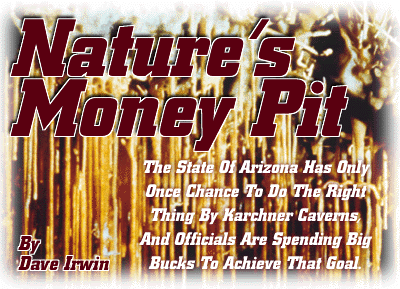
IT'S JUST A hole in the ground. Arizona has a lot of them.
But Karchner Caverns is the most spectacular natural negative
space to grace the state since the Grand Canyon. It's already
being listed among the top 10 caves in the world, because of its
unique formations and pristine condition.
Turning this underground wonderland in the Whetstone Mountains
into the major tourist attraction it could be has become an expensive
and time-consuming task for the State Parks Department. More than
10 years after acquiring the property in a supersecret land deal,
opening day is still nowhere in sight.
"No one wants to see this park open more than we do,"
says State Parks Director Ken Travous. He has good reason, because
Karchner has become a money pit, consuming vast quantities of
his department's resources.
 Travous has been with the project since he became director in
1987 and is one of the biggest advocates for the preservation
of the cave. When he came to the job, one report listed the department
49th in the country, and the Parks Department was looking for
a rock to crawl under. And then, fortunately, Karchner became
available, the largest project the department had ever attempted.
Travous has been with the project since he became director in
1987 and is one of the biggest advocates for the preservation
of the cave. When he came to the job, one report listed the department
49th in the country, and the Parks Department was looking for
a rock to crawl under. And then, fortunately, Karchner became
available, the largest project the department had ever attempted.
"We don't have a prior administration to blame if we screw
this up," Travous says, only half joking. He now spends two
or three days a week at Karchner, helping manage the project,
looking for ways to streamline the work and make everything as
efficient as possible.
Karchner was supposed to be the parks system's cash cow, supporting
development throughout the state with fees from the estimated
100,000 to 150,000 visitors a year eager to see a pristine wet
cave.
"Wet cave." That's the problem and the magic of Karchner:
It's a wet cave, alive and still growing in a complex interplay
of geology, hydrology, weather and other variables.
Humans had never walked inside Karchner Caverns until 1974, when
Tucsonans Randy Tufts and Gary Tenen discovered it. Preserving
the cave from a variety of threats, including vandalism, shoddy
development and its own popularity, has been the goal ever since.
Nature, unhindered by the Americans with Disabilities Act or
OSHA regulations, built the caverns to its own fractal logic.
But turning that raw material into a state park without damaging
the cave in the process has been complex and expensive. Developing
the cave is akin to capturing King Kong, and rather than plopping
him on a stage, you take his natural ecosystem, and unobtrusively
build fully wheelchair-accessible observation points for all of
the ape's activities and interesting body parts, while hoping
he never notices you watching.
Back in 1995, Karchner Caverns State Park was scheduled to open
in November 1997. That date was pushed back in January 1997, when
it was apparent that construction was progressing more slowly
than anticipated.
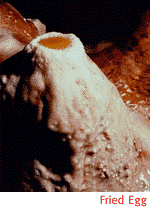 "There was no projected budget or timeline until January
1995," Travous says. "We had no idea how much trouble
the tunnels were going to be."
"There was no projected budget or timeline until January
1995," Travous says. "We had no idea how much trouble
the tunnels were going to be."
The main culprit for the delays was the tunneling and now the
difficulty of the work inside the cave.
"I should have said back in '95 that the cave will open
in 2010 and cost $100 million, and then everyone would have been
happy when we came in under budget and ahead of schedule,"
Travous says.
Park officials now steadfastly refuse to speculate when the cave
will be ready for public viewing. They concede that at the present
pace, it could be two or three more years or even longer, before
the 3,500 feet of cave trails and hidden lighting are completed.
"We are using the resources allocated to us," is all
that Bob Burnett, project manager for cavern development, will
say. "We will open in the future."
Officials cite the frustrating difficulties of transforming the
near pristine underground area into a place where as many as 600
tourists each day can safely and casually stroll without bumping
into each other or damaging the fragile cave environment.
IN THE MEANTIME, the above-ground infrastructure is almost complete.
Parking, power lines, water, sewage, a campground and nature trails
are ready for visitors. A 19,000-square-foot Visitors Center has
been completed. Exhibits explaining the cave are being finished.
The turnstiles are installed.
But the Visitor Center and campgrounds will not open, officials
say, until the cave itself is ready, further reducing potential
income.
Costs of the delay are straining the entire State Parks system.
Funding for Karchner Caverns comes from legislative allocation,
through the Heritage Fund and through user fees from the other
state parks.
Remember all that cash collected at Picacho Peak when you went
to see the El Niño-inspired wildflowers? Right now, that
money is disappearing into Karchner.
When completed, the project is expected to be over budget by
nearly $10 million, according to a recent Arizona Republic
article, a figure that officials do not dispute. Originally estimated
in 1995 to cost $21 million, the Karchner project, they now estimate,
will be around $30 million, assuming nothing else untoward happens
during construction.
To illustrate what can go wrong, test bores for one section of
the tunnel did not show a hidden fault line that keeps collapsing
the roof. Eventually, construction slowed to inches a day at a
cost of $9,000 a linear foot.
Nonetheless, although the Legislature has said they want Karchner
open in a year, no one is sure what to do if that doesn't happen.
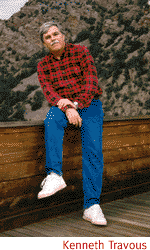 "I'm disappointed, but not concerned," says Sen. Gus
Arzberger, D-Dist. 8, says. Arzberger's district includes the
cave, and he also sits on the Senate Appropriations Committee.
"I believe they're doing everything they can. If you destroy
it, we won't get it back. It's going to pay back a hundredfold
over time," he says confidently.
"I'm disappointed, but not concerned," says Sen. Gus
Arzberger, D-Dist. 8, says. Arzberger's district includes the
cave, and he also sits on the Senate Appropriations Committee.
"I believe they're doing everything they can. If you destroy
it, we won't get it back. It's going to pay back a hundredfold
over time," he says confidently.
Because of the difficulties of maintaining a low-impact construction
site within the cave, officials aren't even sure how much of the
work has been completed and how much more there is to do. One
estimate is that half of the of trails have been roughed in. But
officials concede some of the most difficult work still lies ahead
in the Throne Room, the most distant room from the entrance. They
also admit that no part of the trail has been completely finished,
and planning for permanent lighting has just begun.
WORK UNDERGROUND IS slow and deliberate. On a recent day,
it consisted of lugging 600 feet of 8-inch-thick high-pressure
hose into the cave in 20-foot sections, locking it all together,
backing a concrete truck up and pumping cement to cover an 8-square-yard
area of trail. Then workers flushed the hose and carried it back
out. The whole procedure takes the crew about half the shift.
And this is the speedy procedure. In many places, they have to
carry the cement in wheelbarrows to the work site deep within
the cave.
Two entry tunnels have been completed. Now what used to be a
45-minute crawl for workers is down to a few minutes of walking
upright.
Workers are monitored regularly for exposure to naturally occurring
radon gas. And when entering the cave, workers tag in, a procedure
that could help identify individual victims in the event of a
collapse or other disaster. Crews work in two shifts of 34 people
to minimize impact on the cave.
The only power tools allowed are hydraulic hammer drills and
electric saws with carbide blades. Reinforced steel rods must
be carried in ready to use, since welding is forbidden in the
cave. No gas-powered tools that might create fumes or spill oil
are permitted inside. Most of the work is done by hand, pick and
shovel. Debris is hauled out rather than redeposited in the cave.
Debris from the Big Room, which has evidence of animal habitation,
is searched for bones, such as those of the 10,000-year-old Giant
Sloth found in the cave last year. Plastic covers the more fragile
and extensive formations to protect them from dust or accidental
damage. A legislative tour several years ago broke a unique formation
shaped like the foot pad of the Lunar Excursion Module, so there
is a deliberately careful pace to the work.
To stabilize loose aggregate walls, rocks are removed by hand
and individually and invisibly cemented back into place. A house-sized
boulder slipped during tunneling, requiring the instillation of
large concrete supports before work could continue.
Yet the slow, labor-intensive work has become deeply personal
for the workers, many of whom volunteered for the chance to be
a part of the creation of Karchner.
"I'm convinced that we can't work the people in there any
harder than they already are," Travous says.
TO UNDERSTAND THE fiscal drain of Karchner on the rest
of Arizona's parks system, visit Oracle State Park. Oops, you
can't--it's not open to the public.
Oracle State Park and Center for Environmental Education is a
4,000-acre property donated to the state in 1986 by the Kannally
family. Although acquired before Karchner, Oracle's development
was postponed to greenlight the caverns. Facilities at the Oracle
site, 36 miles north of Tucson on the back road to Mt. Lemmon,
include the historical Kannally Ranch house, some ramadas, parking
lots, trails and roads. But a visitors' center and other facilities
costing millions, which officials insist are necessary to open
the park, have not gone beyond the wishful-thinking stage.
Jay Ream, southern regional manager for state parks, notes, "We're
taxing almost all the talent in our agency getting Karchner open.
Karchner has turned out to be larger than expected and more difficult
than we ever expected. Oracle has had to be put on the back burner."
The plan is for Oracle State Park is to use the unique property
with its extensive wildlife habitat as a teaching tool by focusing
on environmental awareness, rather than duplicating nearby Catalina
State Park as a traditional campground/picnic area.
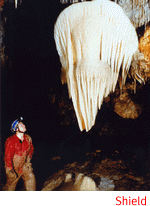 Oracle recently opened for limited environmental education programming.
It will serve approximately 5,000 fee-waivered school kids a year
on field trips. But if the park were fully open, it could serve
as many as 50,000 paying visitors, and along with Biosphere2,
would enhance the town of Oracle as a prime destination for the
growing number of eco-tourists. Because of Karchner, Oracle State
Park will continue to be closed to the general public for at least
four or five more years.
Oracle recently opened for limited environmental education programming.
It will serve approximately 5,000 fee-waivered school kids a year
on field trips. But if the park were fully open, it could serve
as many as 50,000 paying visitors, and along with Biosphere2,
would enhance the town of Oracle as a prime destination for the
growing number of eco-tourists. Because of Karchner, Oracle State
Park will continue to be closed to the general public for at least
four or five more years.
RANDY TUFTS, WHOSE singular goal has been to preserve Karchner
since its discovery, says he and Tenen think the state is doing
a great job.
"The cave is in good hands, as far as we're concerned,"
Tufts says.
That there's a cave to preserve at all is due to years of careful
work and secrecy by Tufts and Tenen.
Tufts has a unique relationship with the cave. Now nearing 50,
he recently completed his doctoral degree in interplanetary geology
at UA, where he's studying Jupiter's moon, Europa, as part of
the Galileo Project. But Karchner Caverns, originally called Xanadu
by the two discoverers, is never far from his thoughts.
"Yeah, I talk to the cave," he admits. "It's like
talking to your dog or something. The cave god has been at work
throughout this project, as if it were orchestrating its own care
by tapping people and saying, 'You're gonna take care of me.'
"We feel responsible for it, and being the discoverers,
we get to exert some influence. What I hope is that once large
numbers of people start seeing it, the cave will develop its own
constituency. When people go into the Throne Room, they'll see
a section by the big, wide mud floor where there's only one trail
that we ever walked along. There are large areas which will have
never been touched. That's an important object lesson."
"I'd decided in high school that I wanted to find a cave,"
Tufts says. He almost found Karchner when he was 19, which he
admits probably would have destroyed it. At that time, he would
have told his caving friends, everyone and his brother would have
trooped into the cave, its virgin qualities forever destroyed
through carelessness and vandalism.
At 26, when, as he says, the cave revealed itself to him, he
immediately felt the responsibility to protect it.
The care that Tufts and Tenen took during their years of stewardship
includes not straying from routes they marked with Popsicle sticks
and even walking without shoes to reduce damage from footprints.
Tufts and Tenen, who is now a successful businessman with several
Alphagraphics stores, managed to keep the cave a tightly held
secret for years, a monumental task in the close-knit spelunking
community.
"We'd seen other caves be substantially destroyed by random
visitation by thoughtless people," Tufts says. "We knew
what would happen if word got out about something this big.
"If this had been in the middle of nowhere, we could have
probably just kept it quiet. But Karchner is so close to the road."
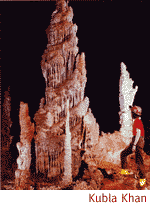 That road, Highway 90, less than a mile from the cave, made the
cave a candidate for salvation by doing the very opposite of keeping
it a secret, a concept of "conservation through commercialism."
They decided that the only way to protect it was to develop it
as a show cave.
That road, Highway 90, less than a mile from the cave, made the
cave a candidate for salvation by doing the very opposite of keeping
it a secret, a concept of "conservation through commercialism."
They decided that the only way to protect it was to develop it
as a show cave.
They approached the owner of the land, St. David educator and
rancher James Karchner. He and his family agreed with the need
to preserve the unique site. Realizing they lacked the resources
to develop it themselves, the Karchner family quietly offered
to sell the land to the State of Arizona.
They were encouraged by Gov. Bruce Babbitt, who surreptitiously
visited the site with Tufts and Tenen. That occasion was marked
by creating a special governor-sized entry route the width of
a trash can, henceforth known as the Babbitt Hole.
Babbitt left office for his ill-fated run for president with
the sale still unsigned. Gov. Evan Mecham was deliberately not
informed of the impending deal by the state for fear he might
somehow manage to screw it up. Gov. Rose Mofford, considered more
stable and thus informed not long after she took office, signed
the bill transferring the land and creating the park in 1988,
just ahead of breaking news reports about the cave's existence.
"It's all based on Randy and Gary's vision," says Park
Manager Jeff Dexter. "We certainly could go through this
a lot faster if we weren't trying to be careful. Years ago, those
would have been acceptable techniques. Everything is being to
done make the cave safe and accessible while protecting the workers.
It would have been easier to build this with stairs, but access
was an issue for us."
The decision to make the entire inside of the cave wheelchair
accessible was "the right thing to do," Travous explains.
"We didn't have to make the cave as fully handicapped accessible.
It was a choice we made. We could have met the requirement for
'reasonable accommodation' by getting people to the Throne Room
overlook."
THERE ARE A lot of caves," says Jeff Dexter. "If
people want to see a cave, they can go almost anywhere to do that.
But in this case, they're going to see one that's in near-natural
condition. So if you only see the cave in terms of economic development,
it's in everyone's best interests to keep it in good shape."
Compare Karchner to Colossal Cave southeast of Tucson. It's dry,
dead and historically vandalized, with steep stairs, visible wiring
at every turn, defaced with broken stalactite stumps from decades
of souvenir hunters. And Colossal is considered a pretty good
cave. Karchner won't put it out of business, but Colossal will
suffer deeply in any comparison to its colorful, living sister
which has been preserved with an almost religious fanaticism.
An estimated 85 percent of Karchner will never have been walked
on when it opens.
Benson, the sleepy town of 5,000 on the San Pedro River, is gearing
up for the resulting tourist largess. Billboards along I-10 already
tout Karchner Caverns, even though it is a non-destination. The
town is building hotels and more fast-food franchises. An airport
with a 4,000-foot runway will open next year.
"We're anxious to get the caves open," says Lynn Stephens,
executive director of the Benson Chamber of Commerce. "There
are a lot of businesses who are banking on the caverns. We don't
want to lose our small-town atmosphere, but at the same time,
we want the tourists. Karchner is going to be the icing on the
cake for Benson."
The park's reservation system will allow for management of the
large volume of anticipated visitors. It will also preclude some
walk-up visitors, especially on weekends, forcing overnight stays,
much to the delight of Benson merchants. Details have yet to be
worked out, since the carrying capacity of the cave is unknown.
The cave's preservation will continue to be the primary goal
after the park opens, even if that means limiting the number of
underground visitors.
Naturally, the potential for large numbers of visitors has created
concerns, including problems of temperature increases, algae growth,
elevated carbon dioxide levels. Every sneeze or drop of sweat
that falls deposits non-native material that, multiplied by 100,000,
could be a threat.
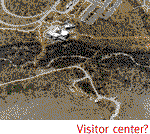 "We don't what the limits of the cave are," says Travous.
"We don't know what happens if the temperature of the cave
goes up 2 degrees."
"We don't what the limits of the cave are," says Travous.
"We don't know what happens if the temperature of the cave
goes up 2 degrees."
"We have three carrying capacities to consider," he
adds. "We have the limits of the above-ground infrastructure,
which is around 150,000 visitors a year.
"The environmental carrying capacity is how much can the
cave take, the heat generated by the people, the carbon dioxide.
We'll have to study what that capacity is, but indications are
that caves are pretty resilient.
"A third carrying capacity is psychological--at what point
does the experience diminish with the number of people that you're
taking through."
Access to the cave may also have to be adjusted to accommodate
bats who live in the Big Room several months a year.
ENTERING KARCHNER CAVERNS through the airlock door, the
atmosphere immediately changes. Relative humidity is nearly 100
percent at a constant temperature of 69 degrees Fahrenheit. It's
a sub-tropical environment in the desert. The darkness is all
enveloping, cut only by the hard-hat lamps. Rocks are strewn along
the floor and there are large muddy areas. Boulders have been
cut for trails, but navigating still requires scrambling. Hundreds
of tiny stalactites decorate the ceiling. Broken soda straw formations
stick in the mud where they fell centuries ago. Calcite flowstone
seeps from fractures.
There is something primal about being inside the earth, especially
in a place that has been treated so reverently. It's like being
in a windowless cathedral, with it's vast boomy sound and the
sacred feeling of enclosure.
A listing of the cave's geological features reads like poetry:
coral pipes, blood-red travertine, moonstone, cave pearls, canopy
overflow, angel's wing, quartz needles, gypsum cotton, rootsicles.
In addition to the usual stalactites and stalagmites, there is
the 51-foot Kubla Kahn column, a world-record 21-foot soda straw,
and an extensive menu of bacon drapery, turnip shields and fried-egg
formations.
Back in daylight, the Visitors Center overlooks the placid valley
with the Dragoon, Huachuca, and Mule Mountains visible in the
distance.
"We've got a million chances to do this wrong," Travous
says. "We only have one chance to do it right."

|





